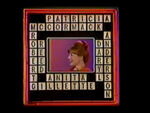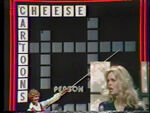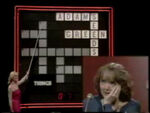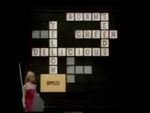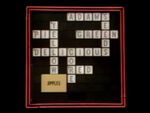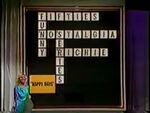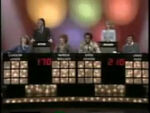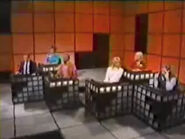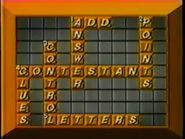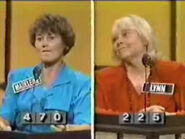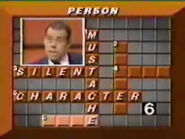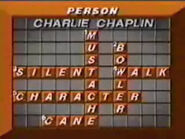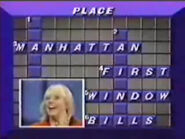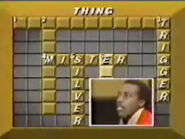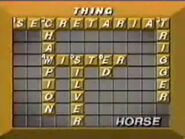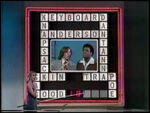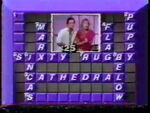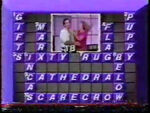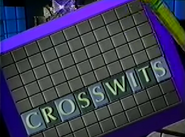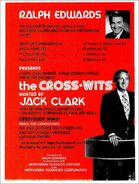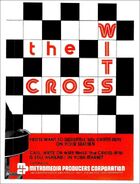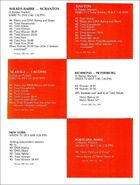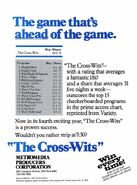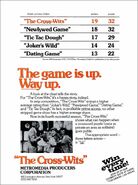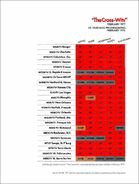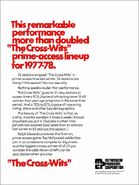| Hosts | |
| Jack Clark (1975–1980) David Sparks (1986–1987) | |
| Announcers (70s Version) | |
| John Harlan Jay Stewart Jerry Bishop | |
| Announcer (80s Version) | |
| Michelle Roth | |
| Broadcast (Daily Syndication) | |
| Clark era: 12/15/1975 – 9/12/1980Sparks era: 9/8/1986 – 4/18/1987 (reruns aired until 9/1987) | |
| Packagers | |
| Ralph Edwards Productions (1975–1980) Crossedwits Productions/ Outlet Productions (1986–1987) | |
| Distributors | |
| Metromedia (1975–1980) ABR Entertainment (1986–1987) | |
CLARK-ERA OPENING:
"From Hollywood, it's The Cross-Wits, with #2 Down, (insert celebrity #1), #1 Across, (insert celebrity #2), #4 Down, (insert celebrity #3), and #6 Across, (insert celebrity #4)! (after credits) And now, let's meet the keeper of The Cross-Wits, Jack Clark!"
SPARKS-ERA OPENING:
"It's the first word in television game shows, The All-New Crosswits! Today's special guest stars: (insert celebrity guests). Today, one of our contestants can win one of these three fabulous cars, and a vacation of a lifetime to (insert destination), on The All-New Crosswits! Here to help us figure it all out is our host, David Sparks!"
The Cross-Wits (also formerly known as The All-New Crosswits) featured two contestants with the help of their two celebrity partners playing crosswords for cash & prizes.
Gameplay[]
Main Game[]
Two teams of three (consisting of two celebrities & one contestant), competed in a game of solving crossword puzzles in which the words in the puzzle were clues to a person, place or thing.
To start, the subject of the master puzzle was given in each round. The contestant in control chooses which position in the puzzle to play. Then the host would announce the clue to that hidden word, and the celebrity would have seven seconds to guess it. If the celebrity's time was up, then the contestant captain had to then rescue the team by answering the same clue; a miss from the captain meant they lost control of the puzzle. Each time the team in control guessed the word correctly, the team would earn points times the number of letters in the answer and kept control.
If at any time the contestant knew the solution to the master puzzle, he/she could choose to solve it. Solving the master puzzle earned bonus points (ten times the letter value) and won the round. The team with the most points after three puzzles or when time was called won the game and moved on to the Crossfire round.
Clark Version[]
In the 1970s version with Jack Clark since this was taped before the era of advanced computerized graphics, the game board was manually operated. The game board was a 10×10 grid (save for the bottom two where the timer was located). It had light boxes that displayed the letters. Since the numbers were too small for the viewers to see, the positions were pointed out by the show's hostess Jerri Fiala with the use of a pointer (similar to what a teacher used in school at the time). The board also had a special box which housed the puzzle's solution and black cards to cover up the solution. When the puzzle was solved, Jerri peeled it off to reveal the right solution.
On a player's first turn at a puzzle after choosing which position in the puzzle to solve, he/she also chose which star partner to guess it first. After that the celebrities took turns.
In all rounds each correct answer was worth 10 points a letter (ex. the word "scientist" is nine letters long, so this word would be worth 90 points), and solving the puzzle was worth 100 points more.
In subsequent seasons, contestants also won a prize for solving the puzzle, and solving the puzzle on the first clue (first two rounds during Seasons 2–4, only Round 2 for the final season) won a new car. The subject of the master puzzle was not revealed at the time and required the use of a special triple question mark card to hide the subject. In case a car was won in the first round, the category of the puzzle would be revealed for the second round.
When solving the master puzzle, the team in control was allowed to first take a seven second conference before the contestant could guess (no conference, but five seconds of thinking time for the contestant, if a car was involved).
The team who solved the puzzle in the first round also began the second round when the rules changed to only offer a car in the second round; this change was made so that a team did not intentionally lose the first round in order to have a better shot at the car. Prior to & after this, trailing teams started the next round.
In the final season, exceeding 1,000 points won $1,000.
Should time run out in the middle of a puzzle, only the team controlling the chosen clue at that time could answer the clue and solve the puzzle for another prize regardless of if the contestant could win or not.
Sparks Version[]
Unlike the 1975 version, this version's game board was completely computer generated, and therefore required no model to point out the letters. The puzzles & current scores were shown on an off-camera, off-stage TV monitor.
The subjects & puzzles were now indicated by color:
Red = Person
Blue = Place
Gold = Thing
In the first two rounds each correct answer was worth 5 points a letter, and solving the puzzle was worth 50 points more, while the last round had correct answers & the master puzzle be the same value as the original. At some point in the series the second round offered 10 points a letter and 100 points for solving the puzzle; and in the third puzzle, the points increased to 20 points a letter and 200 points for solving the puzzle. At another point in the series all rounds offered 5 points a letter and 50 points for solving the puzzle.
There was also a "Mystery Word" in one round; and correctly guessing that word won a prize in addition to the points.
The winner of the game won $250.
Crossfire Round (Bonus Round)[]
In the Crossfire round, the winning contestant & the celebrity of his/her choosing had 60 seconds to solve 10 clues. None of the words in the Crossfire puzzle were clues to a master puzzle. Solving less than 10 clues won modest prizes but solving all 10 won a grand prize.
Clark Version[]
In this Crossfire round, the winning contestant had a choice of one of the two celebrities he/she was partnered with to play the round. The more words guessed, the bigger the prize, and completing the entire Crossfire puzzle won a big trip.
Sparks Version[]
In this Crossfire round, the winning contestant had a choice of all four celebrities to play the round with. The Crossfire puzzle appeared in a purple grid. In this round, the contestant won a consolation prize if he/she didn't complete the puzzle, and completing the entire Crossfire puzzle won a trip, and the right to win a car.
The Car Round[]
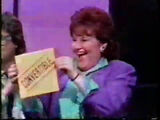
Edie McClurg holding the convertible card in excitement.
In the Car Round, the three remaining celebrities each held a box containing the names of three cars, one in each box. The winning contestant selected which car to play for, then chose the celebrity he/she thought had that chosen car. If the player was right, the car was his/hers. The trip was not at risk, win or lose. For a time, all four celebrities played the car round, and a corresponding fourth box was added to the mix; if chosen, it was worth $1,000 to the contestant.
For the first two taped episodes, the car round was staged differently: rather than holding boxes containing the names of the three cars offered, the celebrities held the keys to each of the three cars. After choosing a celebrity, that celebrity attempted to open the chosen car with his/her key.
More Pictures[]
Tickets[]
Trade Ads (Clark)[]
Trade Ads (Sparks)[]
International Versions[]
In Poland, Kryzowka Szczescia ("Crossword Luck") ran on PTV Echo, Regional TVP, TVP Wroclaw, TVP Polonia and TVP2 from 1995 until 2003, the host were: Agata Mlynarska, Magda Molek, Marek Obszarny, Krysztof Holowczyc, Kryzsztof Mielanczuk, Krysztof Rogala, Rafal Kubacki, Tomasz Stockinger and Zdzislaw Smektala. This version used a live band to play music cues during the show, including the main theme.
In the United Kingdom, Crosswits ran on ITV from 1985 to 1998, originally hosted by Barry Cryer followed by Tom O'Connor later in its run. Each contestant would be teamed with one celebrity and each letter was worth a point and solving the main solution scored 10 points. The highest scoring player played the 60-second Crossfire puzzle for a holiday.
Rating[]
Inventor[]
Jerry Payne
Music[]
1975 - Ron Kaye, Buddy Kaye, Phillip Springer (according to The Encyclopedia of TV Game Shows, 3rd Edition (1998), by David Schwartz, Steve Ryan, & Fred Wostbrock)
1986 - Andrew Belling
Studios[]
Metromedia Studios, Los Angeles, CA (Clark version)
CBS Television City, Los Angeles, CA (Sparks version)
End-of-Show Disclaimers[]
"All trips awarded on The Cross-Wits is subject to availability." - Announcer (1975-1980)
"Some comedy lines were furnished to celebrities." - (1975-1980)
“In some cases, today’s contestants have agreed to prize substitutions and may not receive the exact prizes announced as won on this program.” - Michelle Roth (from the first two taped episodes in 1986)
Trivia[]
Before he hosted The All-New Crosswits, David Sparks hosted an unsold 1986 pilot called On a Roll.
Two episodes of the Sparks version (featuring Rosie O'Donnell and Arsenio Hall respectively) were aired by GSN on October 26, 2014.
Unlike most other shows, the credits on the 1970s version were seen at the beginning rather than the end, after the celebrities were introduced, but before Jack Clark was introduced.
Current crossword game show People Puzzler follows the same scoring format as The Cross-Wits, except with a 100 point bonus for three consecutive correct words replacing the 100 points for solving the master puzzle. In addition, the 2-player Head to Head Showdown plays similar to the Crossfire round.
Links[]
The Cross-Wits @ Tim's TV Showcase
Rules for Crosswits @ Loogslair.net
James Vipond's The All-New Crosswits Page



